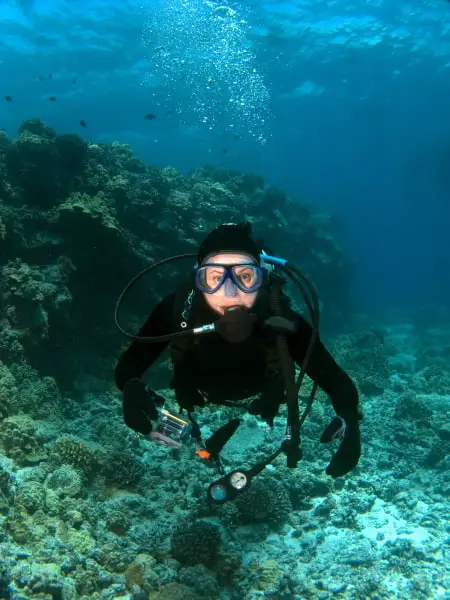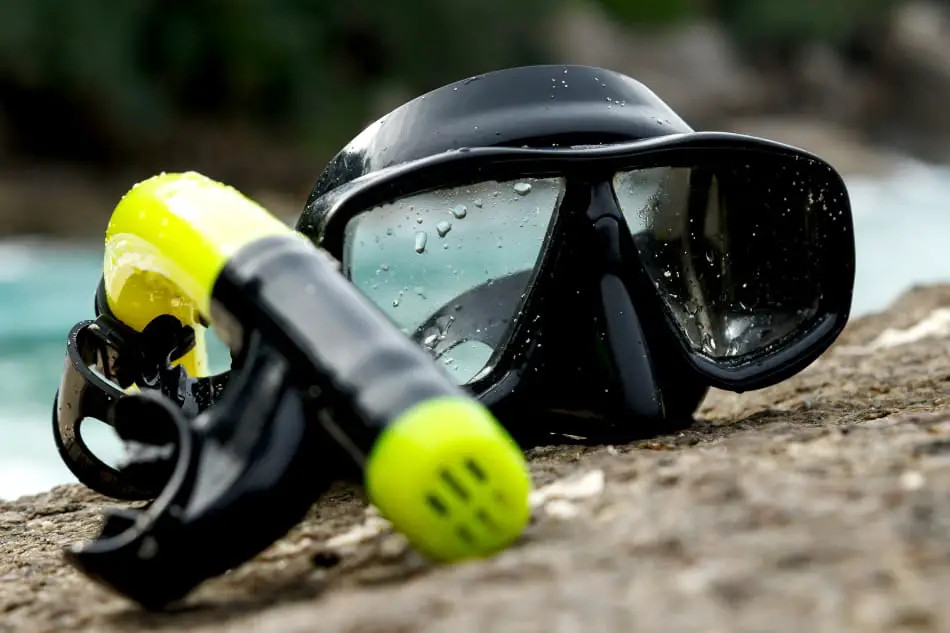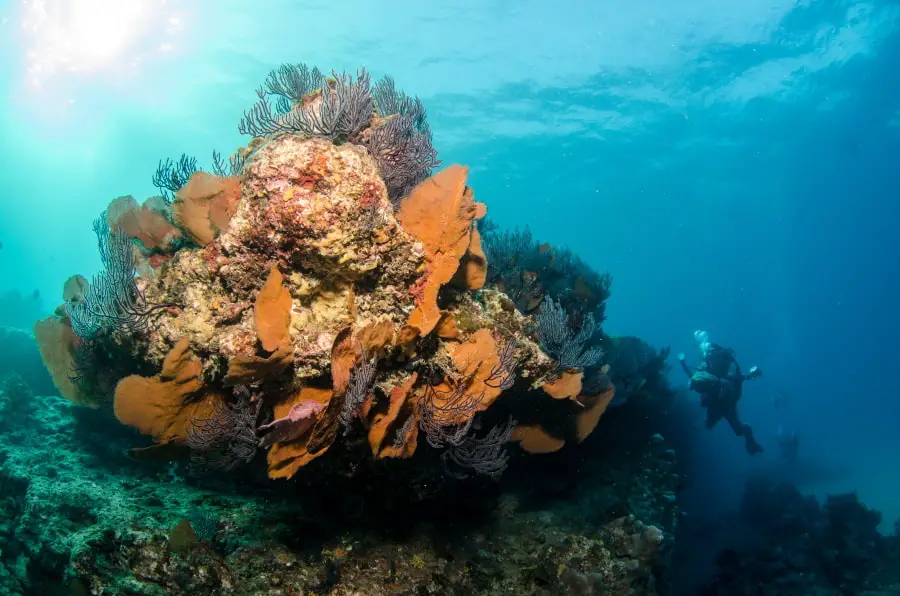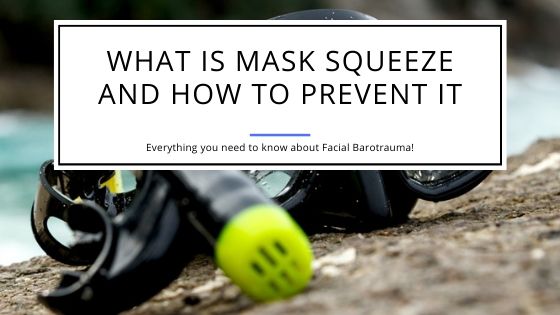What Is Mask Squeeze and How to Prevent Facial Barotrauma
Scuba diving can present a number of risks for a diver, such as decompression sickness, gear malfunction, nitrogen narcosis, and the most dangerous: drowning. Of course, these are the most obvious risks of scuba diving. Less dangerous but still a common problem is to experience mask squeeze when you’re scuba diving.
Many divers are unaware that their own masks can cause serious problems, such as mask squeeze (also known as facial barotrauma or face squeeze). While it isn’t life-threatening or serious, it can cause discomfort and keep you from scuba diving until the symptoms have cleared up. Let’s check out in more detail what it is and how you can prevent mask squeeze.
What is Mask Squeeze?
Mask squeeze is the result of a lack of equalization of air pressure inside the mask. This causes the mask to get compressed against the face, which can eventually make the small blood vessels around your eyes burst. If you’re having a hard time imagining what that would feel like, just imagine your entire face getting sucked into a vortex (your mask) due to the difference in pressure inside the mask when you scuba dive. Don’t underestimate the damage mask squeeze can cause.
The signs and symptoms of mask squeeze include:
- Redness and bruising on the face
- Experiencing pressure on your face
- Nosebleeds
- Red face and eyes
- Blood spots in the whites of the eyes
- Changes in vision (in severe and rare cases)
Fortunately, you can take certain measures to prevent mask squeeze from happening in the first place.
How Does Facial Barotrauma Happen?
Mask squeeze can be the result of a number of factors, such as:
- Not exhaling in the mask as you descend into the water. Since this step is necessary to equalize ear pressure, most divers eventually remember to equalize the air space in the mask when they experience discomfort. You can easily do this by exhaling through your nose into the mask and therefore preventing mask squeeze before you experience it. However, the increased pressure of the mask may not be noticeable until the diver has resurfaced – Was a vintage scuba diving mask worse?
- An ill-fitting mask can also cause mask squeeze, especially if the mask is too small or too tight.
- Facial barotrauma can also occur if you’re trying too hard to prevent water from entering your mask. It’s natural for a bit of water to enter your mask at some point (this doesn’t mean your mask isn’t a good fit). If this does happen, simply tilt your head up, press the top of the mask and exhale. This will create a little pocket at the bottom of the mask for the water to escape. Don’t press the mask against your face before entering the water.
- Descending too quickly in the water can also be a cause of mask squeeze. Keep an eye on your dive computer to prevent a rapid descent and prevent mask squeeze easily.
Divers tend to forget what they need to do to prevent squeezing of their face from the mask, especially if they’re beginners. However, if you do take the necessary precautions you can avoid the discomfort and pain caused by mask squeeze.
Are Beginners More Prone to Mask Squeeze?
New divers are more susceptible to mask squeeze since they are so focused on looking after their equipment and familiarizing themselves with the water that they don’t even know when mask squeeze is happening. It is important to just remember the first rule of scuba diving: breathing.
As long as you exhale through your nose as you descend, you’ll be fine and you’ll be preventing mask squeeze from happening. This unfortunately is probably the most common cause of mask squeeze specifically with new divers.

How Do You Prevent Mask Squeeze?
Here is everything you can do to prevent mask squeeze:
Choosing the Right Mask
While a simple mask that only covers your eyes is alright for snorkeling, it isn’t suitable for scuba diving. Your scuba mask should be able to equalize water pressure as you descend. Most scuba masks have nose valves that help divers equalize the air space between their face and mask without the fear of inhaling water.
Choose a right-sized mask. The mask shouldn’t be too tight or too well-fit before you get in the water. The water pressure during descent will automatically create suction on your mask so that it doesn’t move away from your face. The mask is a good fit it sits comfortably on your face and stays in position with a bit of pressure, even if the straps are undone (you can test it by holding the mask against your face and inhaling- if the mask stays in place without being held, you’re good to go).
Masks with silicone skirting are the best option since they sit comfortably on your face and prevent bruising due to the mask being pushed against your face because of increased water pressure.
Descending Slowly
The key, if you want to prevent mask squeeze, is to descend slowly and equalize the pressure between your face and mask as you descend. The best way to do this is to inhale and then exhale through your nose as you descend: not only does this equalize ear pressure; it also equalizes the pressure inside your mask.
Some dive instructors recommend that you put your mask on after you enter the water until you master descending properly.
Equalize Pressure
It is essential for a diver to equalize pressure in their mask as they descend. The best way to do this is to exhale through the nose into the mask, (similar to the way the diver clears out any water that may have entered the mask).
Most divers have a tendency to exhale small amounts of air through their nose, which is sufficient to equalize the pressure. Those who have a habit of breathing through their mouth need to make a conscious effort to exhale periodically as they descend. Anytime you experience suction because of your mask, you’ll need to equalize the air pressure inside. The best thing to do is to exhale every time you’re done equalizing your ear pressure.
There is no problem and need for pressure equalization as you ascend to the surface. As the water pressure decreases, the air inside will expand and sputter out in bubbles from under your mask.

How to find the Best Full Face Dive Mask – Reviews and Guidance
Does Mask Squeeze Hurt?
Mask squeeze causes bruises around the eyes, blood specks in the white spaces of the eyes and swelling. The good news is that serious damage to your eyeball is rare. Although your eyes may seem like they’re in terrible shape, the damage is not as serious as it appears. In fact, it usually clears up on its own.
In some severe cases, this hemorrhage may last longer and you can even experience pain in your eyes or obstruction of vision. If this happens, visit a doctor immediately. Doctors may recommend antibiotic drops to prevent an eye infection from occurring.
Does Mask Squeeze Go Away?
Unless you experience pain or visual discomfort, there is no treatment needed for a facial squeeze from your dive mask. The redness around and inside your eyes eventually fades away on its own. However, if you are experiencing pain and vision problems, consult a medical professional immediately. Although rare, these symptoms are not totally unheard of.
The side effects of mask squeeze can take up to a fortnight or more to clear up. Before your skin clears up, it is likely to get worse as the blood and edema that has surfaced needs to be reabsorbed into your system. The redness will spread downwards and fade to a greenish-yellow color on your face before fading.
Can You Dive with Face Squeeze?
If you have experienced face squeeze, it is recommended that you shouldn’t dive until all the symptoms have cleared up. This includes both pain in the eyes and any visual symptoms, such as redness of the eyes and face.
The side effects will take some time to fade, and the red bruises will fade to yellow before completely disappearing. Once your face and eyes are a hundred perfect back to normal, you’re ready to dive again.
What Happens if You Dive with Mask Squeeze?
Diving soon after you’ve experienced mask squeeze can make the symptoms worse and can lead to nose bleeds. However, there are some divers who believe that it is okay to dive with mask squeeze as long as you inject extra air inside your mask. While it is advisable not to take such a risk, the decision is up to you.
Can You Get Mask Squeeze From Snorkeling?
Mask squeeze is dependent on descent, so snorkelers are unlikely to experience it since they don’t go deeper than a few feet and the pressure differential is not that great. However, there have been rare cases where snorkelers have experienced face squeeze. This may be caused by:
- A mask that was on too tight
- Hair that may have gotten trapped in the mask and caused the mask to compress against the face
- Plastic straps- many snorkelers recommend using neoprene straps since they are more comfortable and won’t get too tight.
As with mask squeeze during scuba diving, the treatment is the same. If the symptoms are characterized by redness and bruising, let it be and it’ll heal overtime. If there is visual discomfort, seek medical help.

How Deep Do You Have to Dive to Get Facial Barotrauma?
At sea level, air pressure is 1 bar (or 1 atmosphere). Simply diving to a depth of 10 meters doubles this pressure since water is significantly denser than air. For every additional 10 meters you dive, the water pressure goes up by 1 bar.
Mask squeeze can occur at depths of 10 meters or less, which is why it is crucial to let beginners know about the preventive measures and remind older divers too. At this depth, the volume of air is halved. This means that 50% more air is needed from the lungs to compensate for the reduced volume of air in the mask. This is why divers need to exhale as they descend.
Final Thoughts
Mask squeeze is not a very serious injury. It usually goes away on its own or can be treated with the help of antibiotic drops. That being said, it can be a bit painful and can make you look like you stepped out of a horror movie (until the redness and bruising clear up).
This is also the reason regular swim goggles can’t be used for scuba diving. The nose valve of a scuba mask is essential to enable the scuba diver to exhale through their nose and equalize pressure inside the mask to prevent it from getting compressed against their face. As long as you do this and have the right-fitting mask, you won’t have to deal with the discomfort of facial squeezing.
Just remember that if you do experience mask squeeze and it is affecting your vision or causing pain in your eyes, you need to get a doctor’s help immediately. While all other side effects dissipate on their own, obstruction of vision and pain may require medication or treatment.

